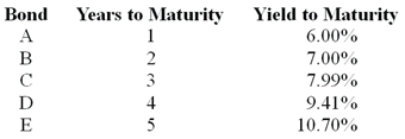A) 5.0%
B) 5.5%
C) 7.6%
D) 8.9% PV0 = 60
Correct Answer

verified
Correct Answer
verified
Multiple Choice
The invoice price of a bond is the ________.
A) stated or flat price in a quote sheet plus accrued interest
B) stated or flat price in a quote sheet minus accrued interest
C) bid price
D) average of the bid and ask price
Correct Answer

verified
Correct Answer
verified
Multiple Choice
An investor pays $989.40 for a bond. The bond has an annual coupon rate of 4.8%. What is the current yield on this bond?
A) 4.80%
B) 4.85%
C) 9.60%
D) 9.70%
Correct Answer

verified
Correct Answer
verified
Multiple Choice
Which one of the following statements is correct?
A) Invoice price = Flat price - Accrued interest
B) Invoice price = Flat price + Accrued interest
C) Flat price = Invoice price + Accrued interest
D) Invoice price = Settlement price - Accrued interest
Correct Answer

verified
Correct Answer
verified
Multiple Choice
A coupon bond which pays interest of 4% annually, has a par value of $1 000, matures in 5 years, and is selling today at $785. The actual yield to maturity on this bond is ________.
A) 7.2%
B) 8.8%
C) 9.1%
D) 9.6% $785 = $40
Correct Answer

verified
Correct Answer
verified
Multiple Choice
Yields on tax-exempt bonds are typically ________ yields on corporate bonds of similar risk and time to maturity.
A) lower than
B) slightly higher than
C) identical to
D) twice as high as
Correct Answer

verified
Correct Answer
verified
Multiple Choice
A bond has a 5% coupon rate. The coupon is paid semi-annually and the last coupon was paid 35 days ago. If the bond has a par value of $1 000, what is the accrued interest?
A) $4.81
B) $14.24
C) $25.00
D) $50.00
Correct Answer

verified
Correct Answer
verified
Multiple Choice
A coupon bond which pays interest of $60 annually, has a par value of $1 000, matures in 5 years, and is selling today at a $75.25 discount from par value. The current yield on this bond is ________.
A) 6.00%
B) 6.49%
C) 6.73%
D) 7.00%
Correct Answer

verified
Correct Answer
verified
Multiple Choice
The bonds of Elbow Grease Dishwashing Company have received a rating of 'C' by Moody's. The 'C' rating indicates the bonds are ________.
A) high grade
B) intermediate grade
C) investment grade
D) junk bonds
Correct Answer

verified
Correct Answer
verified
Multiple Choice
A zero-coupon bond has a yield to maturity of 5% and a par value of $1 000. If the bond matures in 16 years, it should sell for a price of ________ today.
A) $458.00
B) $641.00
C) $789.00
D) $1 100.00
Correct Answer

verified
Correct Answer
verified
Multiple Choice
Which of the following bonds would most likely sell at the lowest yield?
A) A callable debenture
B) A puttable mortgage bond
C) A callable mortgage bond
D) A puttable debenture
Correct Answer

verified
Correct Answer
verified
Multiple Choice
A 1% decline in yield will have the least effect on the price of the bond with a ________.
A) 10-year maturity, selling at 80
B) 10-year maturity, selling at 100
C) 20-year maturity, selling at 80
D) 20-year maturity, selling at 100
Correct Answer

verified
Correct Answer
verified
Multiple Choice
Consider a newly issued TIPS bond with a three year maturity, par value of $1000, and a coupon rate of 5%. Assume annual coupon payments.  What is the nominal rate of return on the TIPS bond in the first year?
What is the nominal rate of return on the TIPS bond in the first year?
A) 5.00%
B) 5.15%
C) 8.15%
D) 9.00%
Correct Answer

verified
Correct Answer
verified
Multiple Choice
Consider two bonds, A and B. Both bonds presently are selling at their par value of $1 000. Each pay interest of $120 annually. Bond A will mature in 5 years while Bond B will mature in 6 years. If the yields to maturity on the two bonds change from 12% to 14%, ________.
A) both bonds will increase in value but Bond A will increase more than Bond B
B) both bonds will increase in value but Bond B will increase more than Bond A
C) both bonds will decrease in value but Bond A will decrease more than Bond B
D) both bonds will decrease in value but Bond B will decrease more than Bond A
Correct Answer

verified
Correct Answer
verified
Multiple Choice
Consider the following $1 000 par value zero-coupon bonds:  The expected one-year interest rate four years from now should be ________.
The expected one-year interest rate four years from now should be ________.
A) 16.00%
B) 18.00%
C) 20.00%
D) 22.00%
Correct Answer

verified
Correct Answer
verified
Multiple Choice
TIPS are an example of ________.
A) Eurobonds
B) convertible bonds
C) indexed bonds
D) catastrophe bonds
Correct Answer

verified
Correct Answer
verified
Multiple Choice
A ________ bond is a bond where the issuer has an option to retire the bond before maturity at a specific price after a specific date.
A) callable
B) coupon
C) puttable
D) Treasury
Correct Answer

verified
Correct Answer
verified
Multiple Choice
A ________ bond is a bond where the bondholder has the right to cash in the bond before maturity at a specific price after a specific date.
A) callable
B) coupon
C) puttable
D) Treasury
Correct Answer

verified
Correct Answer
verified
Multiple Choice
Assuming semiannual compounding, a 20-year zero coupon bond with a par value of $1 000 and a required return of 12% would be priced at ________.
A) $97
B) $104
C) $364
D) $732
Correct Answer

verified
Correct Answer
verified
Multiple Choice
Everything else equal, ________ bonds will require a higher promised YTM than ________ bonds.
A) catastrophe; standard
B) non-callable; callable
C) mortgage; debenture
D) AAA rated; BAA rated
Correct Answer

verified
Correct Answer
verified
Showing 21 - 40 of 58
Related Exams